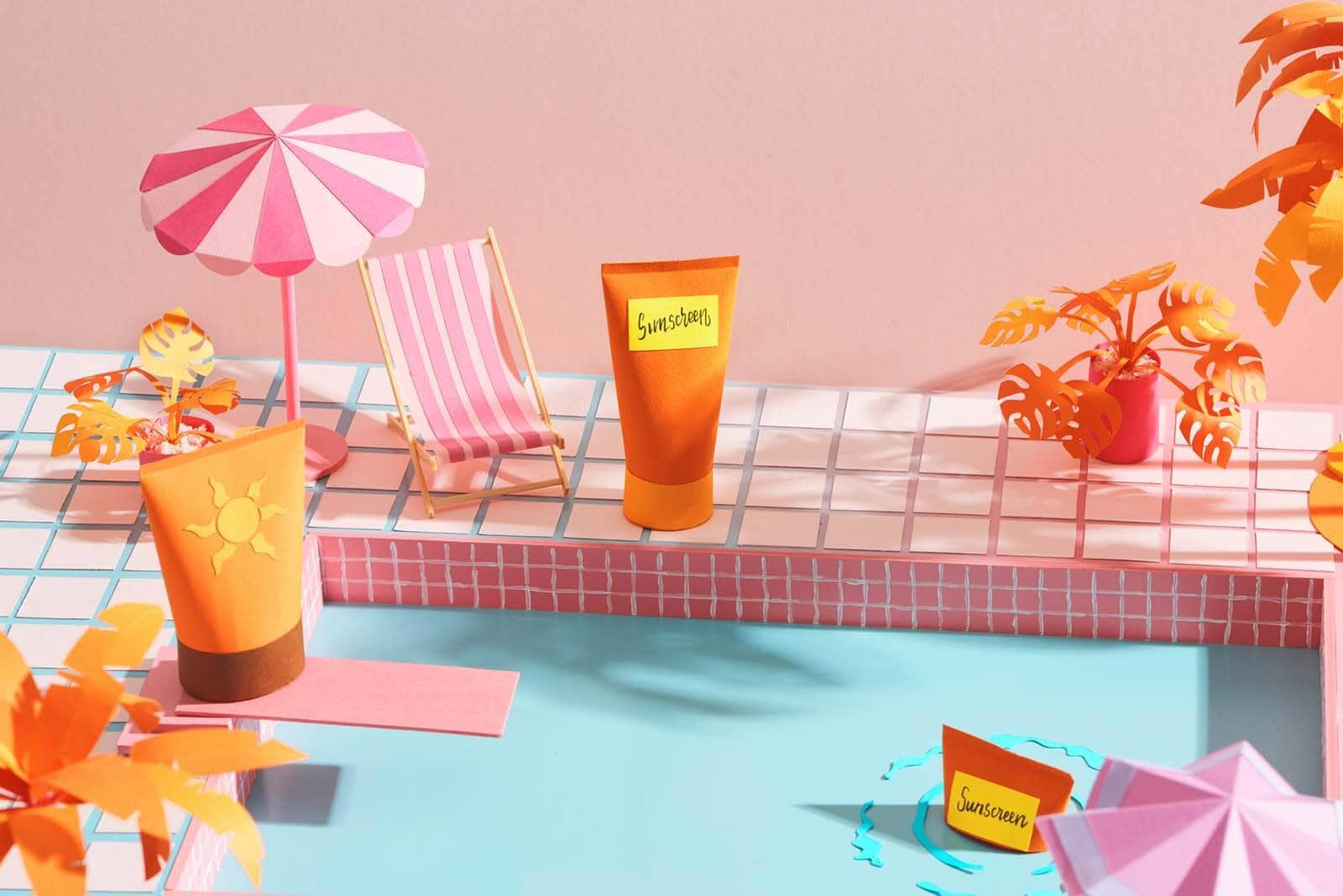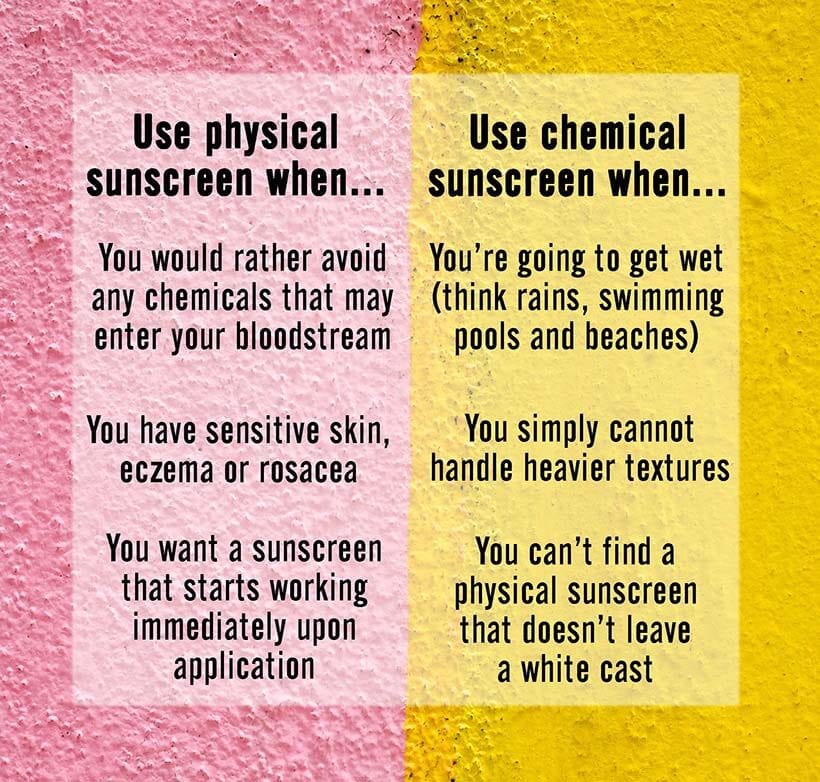{Photograph} voltaic-kissed afternoons on the seaside, picnics beneath the balmy {photograph} voltaic, and totally different people invigorating morning jogs: All of us love the nice and comfortable embrace of daylight. Nonetheless, as we expertise these moments, the {photograph} voltaic’s rays play havoc on our pores and pores and pores and pores and skin, typically forsaking larger than solely a tan.
Enter sunscreen — our armor throughout the course of these invisible foes. Nonetheless not all sunscreens are crafted the an an similar.
The sweetness aisle divides them into two elementary champions: Chemical vs mineral sunscreen. Nonetheless which one ought to earn a spot in your every day routine? What’s the excellence? Which ones work larger? And are there any correctly being risks?
Dive into this whole face-off between chemical and mineral sunscreens. Let’s unearth their mysteries, debunking myths and spotlighting their strengths with this whole info to varied sorts of sunscreen — and top-of-the-line methods to resolve on the exact one for YOU.


Chemical vs mineral sunscreen: What’s the excellence?
There are two essential kinds of sunscreens: Chemical sunscreen and mineral sunscreen.
Mineral sunscreens (typically often called bodily sunscreen or sunblock) embody mineral substances — typically zinc oxide or titanium dioxide. These sit on prime of the pores and pores and pores and pores and skin, making a bodily barrier that blocks and scatters UV radiation previous to it penetrates the pores and pores and pores and pores and skin.
Chemical sunscreens, alternatively, work like a sponge by absorbing UV rays into the pores and pores and pores and pores and skin. As shortly as absorbedthey alter harmful UV rays to heat (a quite rather a lot rather a lot a lot much less harmful sort of energy), then disperse them by the pores and pores and pores and pores and skin.
Formulations that embody every mineral and chemical substances are termed chemical sunscreens.
So, is it the an an similar as pure vs inorganic sunscreens?
Sunscreens are one house the place the time interval “pure” merely should not be all it seems. And some unscrupulous producers play on this to mislead the patrons.
Appropriate correct proper right here, the chemical sunscreens are often called “pure” by science — not resulting from they’re “pure” nonetheless resulting from they embody carbon-carbon bonds.
Mineral sunscreens, alternatively, are “inorganic” as they don’t embody any carbon bonds.
Chemical vs mineral sunscreen: Which is most attention-grabbing?
This is not a one-size-fits-all state of affairs. It relies upon upon upon your pores and pores and pores and pores and skin type, lifestyle, and extra. So, I’ll put out all the data, and you’ll decide which might be going certainly one of many most fascinating sunscreen for YOU!
1. Chemical sunscreens may be absorbed into the bloodstream
For a lot of, this may be primarily a very extremely efficient state of affairs when deciding between varied sorts of sunscreen.
On account of mineral sunscreen has bodily blockers that sit on prime of your pores and pores and pores and pores and skin, it does not enter your bloodstream.
Chemical formulation, alternatively, can have optimistic substances absorbed into your bloodstream.
Is that this a difficulty?
Whereas the jury stays to be out on the correctly being and issues of safety of these substances (not all chemical compounds are harmful!), I am cautious about letting ones like oxybenzone or octinoxate near my physique.
Newest analysis stage out that we may be absorbing way more of these chemical compounds than was beforehand thought, additional underlined by the reality that oxybenzone, which could most likely be a hormone disruptor, has been detected in breast milk.
Equally, the Environmental Working Group (EWG) has revealed that oxtinoxate (a chemical UV filter) has been current in prospects blood ranges at 16 events above the proposed Meals and Drug Administration (FDA) safety threshold.
Nonetheless, as I acknowledged, science has not reached any unanimous conclusions, so this stays a matter of private utterly totally different. I have to err on the aspect of warning, significantly since hormonal disruptions have been my long-term concern.


2. The environmental impression
One state of affairs, nonetheless, is non-debatable — and that’s ample to make me resolve up bodily sunscreens over a chemical components.
Oxybenzone, which is a key ingredient in pretty only a few chemical sunscreens, may be going one amongst many elementary causes of coral bleaching. It’s so harmful to marine life that Hawaii utterly banned it in 2018!
If my dedication between kinds of sunscreen impacts the environment, guess which suggests I’ll go?
3. The excellence in software program program program
Chemical sunscreen ought to go beneath any occlusive skincare, like oils or heavy moisturizers, on account of it should sink into the pores and pores and pores and pores and skin to cease {photograph} voltaic hurt. It moreover takes about 20 minutes to start working (on account of the substances have to be absorbed), so you could’t slap on and immediately step out of the door.
Bodily sunscreen goes on prime of your skincare, barely beneath make-up. They start defending you immediately, so there’s no prepared time required!
4. The question of texture and clogged pores
Every zinc oxide and titanium oxide are non-comedogenic (gained’t clog pores), which makes bodily sunscreen an unimaginable varied you virtually actually have an acne-prone complexion.
Then as quickly as further, chemical sunscreens might need pretty only a few substances that can clog the pores, inflicting pores and pores and pores and pores and skin congestion.
Nonetheless, bodily formulation are sometimes thicker in texture and sit additional rigorously on the pores and pores and pores and pores and skin, which could not be the best wager for an oily complexion.
Chemical sunscreens have additional flexibility of their formulation, allowing them to be lightweight and address pretty only a few pores and pores and pores and pores and skin varieties. For instance, Supergoop Unseen Sunscreen SPF 40 is a chemical sunscreen that dries down matte and works brilliantly for greasy pores and pores and pores and pores and skin — all whereas defending throughout the course of UV delicate.
5. Chemical sunscreens can set off pores and pores and pores and pores and skin reactions
While you’ve ever felt your eyes sting after using sunscreen, it’s most definitely ensuing from chemical filters. Chemical sunscreen merchandise are moreover additional weak to set off pores and pores and pores and pores and skin reactions like contact dermatitis and photosensitivity since pretty only a few energetic substances have been blended for broad-spectrum safety.
One utterly totally different big one: Of us with rosacea-prone pores and pores and pores and pores and skin have elevated prospects of a flare-up with chemical sunscreens as they alter UV rays into heat, which can escalate flushing.
Mineral-based sunscreen, alternatively, has zinc oxide. This anti-irritant and pores and pores and pores and pores and skin protectant is mostly utilized in skincare strains for delicate pores and pores and pores and pores and skin. Neutrogena’s Sheer Zinc Sunscreen Lotion SPF 50 even has the Nationwide Eczema Affiliation’s stamp of approval.
Titanium dioxide (mineral sunscreen) is within the market in an in depth second. Nonetheless, it’d very correctly be a difficulty for these delicate to mineral make-up.


6. Chemical vs mineral sunscreen: Which affords additional security?
Mineral sunscreens with zinc oxide are naturally broad-spectrum, defending throughout the course of UVA and UVB rays. Titanium dioxide moreover protects throughout the course of UVB rays, nonetheless not the complete spectrum of UVA rays (positively one amongst many the rationale why I would really like zinc oxide).
Nonetheless, every can rub or sweat off sooner, requiring additional frequent reapplication for mineral SPF.
Chemical sunscreens may also be broad spectrum, nonetheless you might should affirm for the rating on the label significantly. It is attainable you will wish to seek for one that provides every UVA and UVB security.
PS: Why is it essential to have a broad-spectrum sunscreen that protects throughout the course of every UVA and UVB rays? That’s resulting from every kinds of rays have harmful outcomes on the pores and pores and pores and pores and skin. UVA rays delve deep into the pores and pores and pores and pores and skin, inflicting premature getting outdated, good strains, wrinkles, and darkish spots.
Then as quickly as further, UVB rays primarily set off DNA hurt in pores and pores and pores and pores and skin cells, leading to sunburns and a heightened hazard of pores and pores and pores and pores and skin most cancers. Furthermore, UVB rays quick melanin manufacturing, which results in tanning. Prolonged publicity to UVB may go away the pores and pores and pores and pores and skin additional weak to varied sicknesses and conditions.
7. Chemical sunscreens are additional waterproof
That’s one place the place chemical sunscreens ranking big. Bodily sunscreen tends to sweat and rinse off shortly, not making it the one selection for a day of swimming or water sports activities actions actions actions.
Chemical variations, nonetheless, work larger right correct proper right here as they sink into the pores and pores and pores and pores and skin and gained’t come off so shortly — giving them additional longevity.
8. Mineral sunscreen can produce a white safe
Ah! The huge one. Due to this people resolve out of using a mineral sunscreen: The mineral particles are inclined to create a white safe on the pores and pores and pores and pores and skin (which is very a difficulty for darker pores and pores and pores and pores and skin tones ).
Plus, zinc oxide and titanium dioxide are thicker and take some additional effort to rub in.
Chemical sunscreen substances, alternatively, have a lighter texture, are less complicated to rub into the pores and pores and pores and pores and skin, and don’t give off that ghosting affect.
Winner?
Not primarily, since mineral formulation are constantly bettering, turning into additional lightweight and fewer whitening. Undoubtedly one amongst many essential advances is micronization, which suggests the particles have been made lots smaller to attenuate the white safe.
One among my favorites is the Drunk Elephant Umbra Sheer Bodily Every day Safety SPF 30, with 20% zinc oxide, which supplies a pure glow and broad-spectrum security. La Roche-Posay Anthelios 50 Mineral Terribly Delicate Sunscreen Fluid is one utterly totally different bodily sunscreen with a super-light texture and no white safe.
A variety of mineral-based sunscreens have moved even earlier micronization to nanoparticles (tiny particles of zinc oxide between one and 100 nanometres), which allow the weather to be texturally lighter and extra clear.
As for the talk relating to the safety of nanotechnology? A variety of our our our our bodies, along with the Environmental Working Group, have confirmed that nanoparticles in sunscreen don’t penetrate the pores and pores and pores and pores and skin or set off hurt.


FAQs: Chemical vs mineral sunscreen
Listed beneath are primarily principally most likely probably the most incessantly requested questions on mineral and chemical sunscreens. Have one amongst your express particular person? Drop it contained within the methods beneath, and we’ll get you the alternatives ASAP.
What is the distinction between mineral and chemical sunscreen?
Chemical sunscreens embody pure (carbon-based) compounds that take throughout the {photograph} voltaic’s harmful rays and convert them into harmless heat, whereas mineral sunscreens use inorganic compounds, like zinc oxide or titanium dioxide, to dam rays and replicate them away from the pores and pores and pores and pores and skin.
Is chemical sunscreen OK for acne-prone pores and pores and pores and pores and skin?
Some people with acne-prone pores and pores and pores and pores and skin may uncover chemical SPF irritating. It’s important to resolve on a product labeled “non-comedogenic” and monitor how your pores and pores and pores and pores and skin reacts.
What are the disadvantages of mineral sunscreen?
Mineral sunscreens is extra prone to be thicker, may go away a white safe, and is extra prone to be further sturdy to combine into the pores and pores and pores and pores and skin. They’ll moreover typically really really actually really feel greasier than their chemical counterparts.
Why do people want mineral sunscreen?
Of us may want mineral sunscreens resulting from they’re sometimes well-tolerated, even by delicate pores and pores and pores and pores and skin varieties, current quick security upon software program program program, and are quite rather a lot rather a lot a lot much less weak to set off allergic reactions or irritations.
Does mineral sunscreen go away pores and pores and pores and pores and skin white?
Some mineral sunscreens can go away a white safe, significantly these with the next zinc oxide or titanium dioxide focus. Nonetheless, many fashionable formulations are designed to be additional clear or blendable, with a non-chalky finish.
How do I do know if my sunscreen is chemical or bodily?
Look at the energetic substances on the label. While you see zinc oxide or titanium dioxide, it’s a mineral (bodily) sunscreen. Parts like avobenzone, octocrylene, octinoxate, or oxybenzone stage out a chemical sunscreen.
Are chemical sunscreens safe for coral reefs?
Some chemical sunscreens embody substances like oxybenzone and octinoxate, which have been linked to coral reef hurt. It’s most attention-grabbing to resolve on reef-safe sunscreens when swimming contained within the ocean.
Are there any correctly being factors associated to chemical sunscreens?
Some factors have been raised about optimistic chemical compounds, like oxybenzone, which might have hormone-disrupting properties. Commonly evaluation and choose merchandise from trusted producers.
What’s your form out chemical vs mineral sunscreen? Which one do you prefer?




